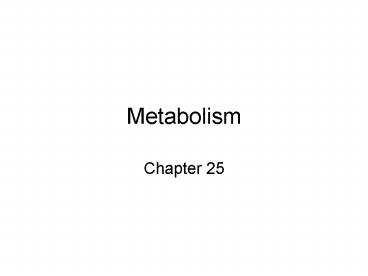Metabolism - PowerPoint PPT Presentation
1 / 42
Title:
Metabolism
Description:
This includes representatives from the 4 major organic ... Glycogenesis/ Glycogenolysis. Gluconeogensis. Summary of metabolic pathways. Lipid metabolism: ... – PowerPoint PPT presentation
Number of Views:114
Avg rating:3.0/5.0
Title: Metabolism
1
Metabolism
- Chapter 25
2
Essential Nutrients
45 50 molecules must be ingested. This
includes representatives from the 4 major organic
molecule groups, plus a number of inorganic
substances such as including water, vitamins and
minerals (Na, Fe, etc.) The USDA has made major
revision in its nutritional recommendations. http
//www.health.gov/dietaryguidelines/dga2005/docume
nt/
3
It was never based on solid science
4
Nutrient A substance in food used by the body
for growth, maintenance, energy and repair.
USDA IOM for young adult female
- Carbohydrates 271g (55) 130g (45 - 65)
- Lipid total 65g (17) 20 25
- saturated 17g (7.8)
- Protein 91g (18) 56g (10 35)
- Water 1500 ml (average) per day.
5
Uses of nutrients
- Carbohydrate Primary energy molecule. Also found
on cell membranes and as part of structure of
connective tissue matrix molecules - Lipid Energy storage, plasma membrane structure,
cushioning, steroid hormones. - Proteins Enzymes, receptors, hormones,
structures of all kinds. Must be complete or
complimentary in order to supply essential
amino acids.
6
Essential amino acids
7
Energy Metabolism
- Metabolism catabolism anabolism
- Cellular respiration is a series of catabolic
reactions that provide energy for the production
of - This energy is used to generate ATP from
phosphorylation of ADP. - It is a series of Redox reactions.
ATP
8
Energy Metabolism Generation of ATP
9
Overview of aerobic respiration
10
Summary of steps of energy metabolism
11
Generation of ATP by substrate-level
phosphorylation
12
Oxidative phosphorylation
13
Overview of cellular respiration
14
Carbohydrate Metabolism
Oxidation of Glucose
C6H12O6 6 O2 6 CO2 6 H2O 36 ATP Heat
15
Glycolysis
It is the first stage in cellular respiration
16
Stepsof glycolysis
17
Aerobic vs anaerobic pathways
18
Overview of Krebs cycle
19
Krebs Cycle
20
The ETC creates an chemiosmotic gradient
21
The Electron Transport Chain
22
Summary of ATP synthesisGains losses
23
Visual summary of cellular respiration
24
Glycogenesis/Glycogenolysis
25
Gluconeogensis
26
Summary of metabolic pathways
27
Lipid metabolismoxidation
28
Metabolism of Triglycerides
29
Amino acid use in Krebs cycle
30
Protein metabolism in the Liver
31
Carbohydrate/fat amino acid pools
32
Interconversion of carbohydrate, lipid and protein
33
Pathways of the Absorptive state
34
The effects of insulin on metabolism
35
The Postabsorptive state
36
Influences of Glucagon on blood glucose levels
37
Composition of Lipoproteins
38
Hypothetical feeding control mechanism
39
Heat Balance
40
Regulatory pathways for homeostatic control of
body temperature
41
Temperature regulation mechanisms
42
Maynard or Hans?































